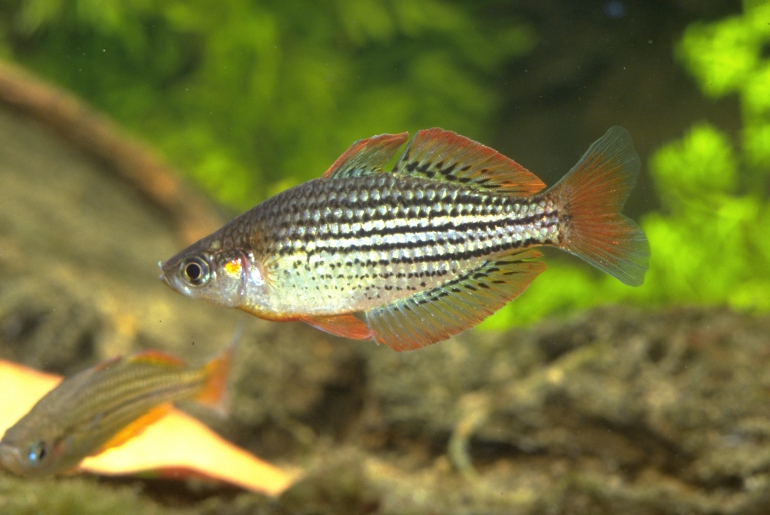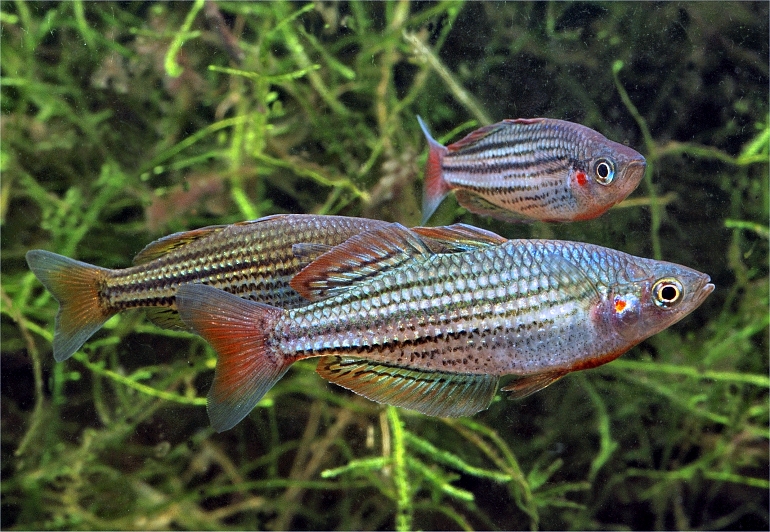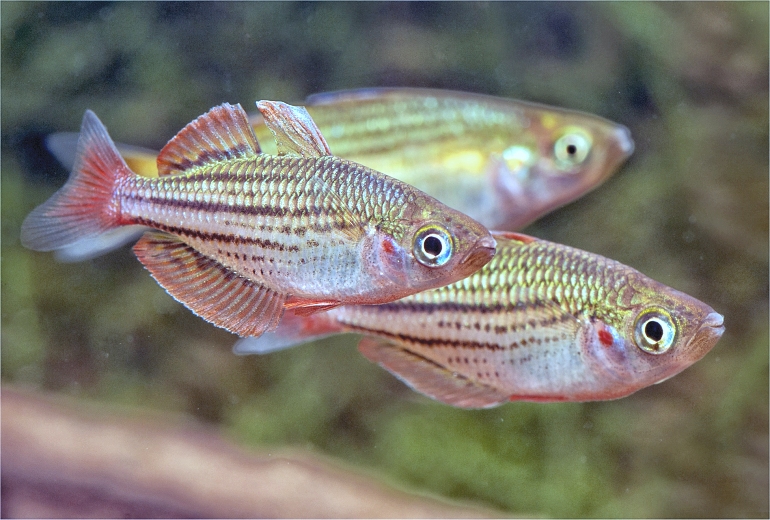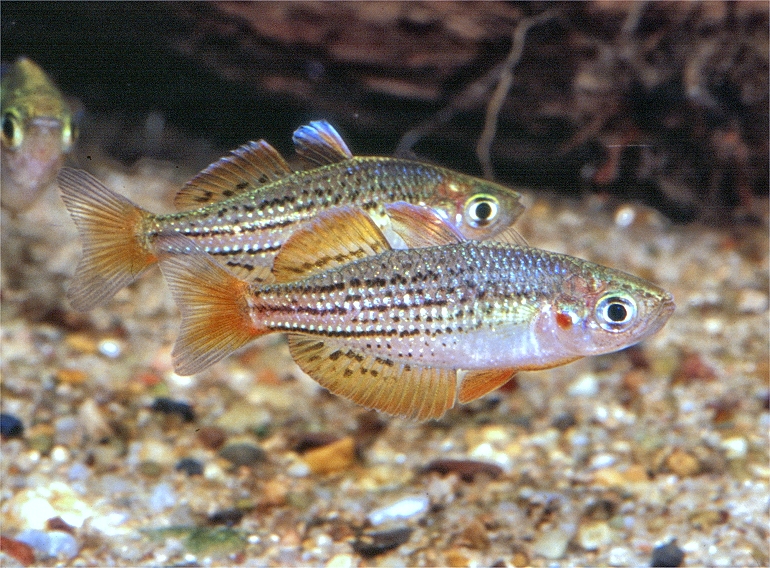|
 |
Melanotaenia maccullochi (Harvey Ck, Russell River) - photo© Gunther Schmida |
Ogilby, 1915
McCulloch's Rainbowfish
Species Summary
Melanotaenia maccullochi were described in 1915 by J.D. Ogilby from two specimens collected from the Barron River, near Cairns in north Queensland, by Mr. A. Anderson. They were named after the ichthyologist, Allan Riverston McCulloch (1885-1925). M. maccullochi is another rainbowfish species that has several geographically isolated populations found in northern Queensland. Several colour forms are known. Melanotaenia maccullochi are generally bronze to brownish on the upper half of the body and brownish to white on the lower half. They have seven or eight lateral body stripes, some continuous others broken, especially when younger; head brownish grey, lips brown to grey, sometimes with a hint of white or orange; small red to orange mark on the upper operculum; iris silver; fins typically light yellow to orange-red near the base grading to darker orange or red across the outer half of the fin, sometimes with a series of brown spots or occasionally lines near the base of the second dorsal and anal fins. Colour intensifies in breeding males with more prominent body stripes and rich red fin colouration. A conspicuous nape stripe has been observed in live fish in aquariums that is 'flashed' on and off by courting and sparring males. It varies from a whitish yellow through to orange-red with colour being variable from different populations. Females are much less colourful, though some do show a hint of the males' colouration.
Melanotaenia maccullochi is readily distinguished from the smaller growing M. wilsoni by a combination of colour, meristic and morphometric differences. Most easily distinguished from M. sahulensis based on base body colour (brownish v. silver-grey), typical body stripe colour (brown and mostly faint v. black and full) and dorsal and anal fin colour pattern (reddish and relatively plain v. uniformly thick black submarginal band forming a tri-tone pattern). Additionally, M. maccullochi has on average a longer predorsal distance and narrower body depth and width.
 |
Melanotaenia maccullochi [Cape Flattery) - photo© Gunther Schmida |
Distribution & Habitat
Melanotaenia maccullochi is native to tropical northeastern Queensland extending from Cape Flattery, Hope Vale and the McIvor River area in the north, through an isolated population in the lower Daintree River area, then from Cairns south to the Cardwell area as far south as Camp Creek (Martin & Barclay 2019). This wide area has considerable regional variability in habitat, but typically consists of swamp and stream environments, ranging from small waterways, larger wetlands and dune lakes, and with microhabitat typically comprising dense cover comprising submerged or emergent vegetation in shallow water (<50 cm) with low turbidity and often tannin stained. In the coastal plains south of Cairns, the species typically occurs in swamps and associated small, low velocity feeder streams and also in artificial drains adjacent to sugar or banana crops. The extensive development of coastal plains has contributed to the demise of this species. It is now confined to a relatively few widely scattered locations and has long been absent in the Barron River, the site of its first capture. The species commonly co-occurs with M. splendida and is often found in association with other wetland fish species particularly Pseudomugil gertrudae.
The natural habitats of M. maccullochi are influenced by seasonal conditions, water depth, flow rates, and the time of day when measurements are recorded. The surface waters of the wet season are amongst the softest in Australia with total dissolved solids being typically below 20 mg/L and hardness and alkalinity consistently below 10 mg/L. Buffering capacity is therefore exceptionally low and as a result these waters are subject to a marked decline in pH, with values sometimes as low as 3.6. The relative uniformity of the wet season provides a marked contrast to the progressive deterioration in water quality throughout the dry season. Conductivity levels are generally higher during the dry season when no fresh water is flowing into the catchment. By the end of the dry season evaporative loss causes a progressive increase in conductivity with a greater than tenfold solute concentration factor. Conductivity generally increases the further downstream you go along a river, but significant discontinuities in this gradient can occur at points of confluence with other tributaries and groundwater springs, etc. The slightly higher pH levels are characteristic of coastal streams as pH tends to increase with salinity. The following range of water conditions have been recorded from their natural habitats:
Water Temperature: 16 - 36°C
pH: 5.4 - 8.4
Alkalinity: 3 - 96 mg/L CaCO3
Hardness: 2 - 84 mg/L CaCO3
Conductivity: 34 - 200 µS/cm
 GS.jpg) |
Melanotaenia maccullochi (Hope Vale) - photo© Gunther Schmida |
Biology
Very little is known about the biology of M. maccullochi in their natural environment. Most information is mainly based on aquarium observations. They are most likely aseasonal spawners, breeding continuously at intervals throughout the year. However, a peak in reproductive activity is usually during the early-wet season, from October to December. Strong sexual dimorphism is present in the species with males typically being brighter in colouration. Before spawning, a bright spawning' stripe is evident in the males. It runs from the tip of the mouth to the first dorsal fin on the dorsal surface of the fish. Females produce between 20-30 eggs each day for several days. Eggs are attached by adhesive threads or tendrils to a range of submerged physical structures, including gravel substrates, woody debris, root masses, aquatic vegetation and submerged marginal (riparian) vegetation, which hide them from predators. However, the eggs are subject to desiccation if the water level drops or to dispersal if there is a flood. It will take around 8-9 days at 28° Celsius for the first young to appear. Larvae achieve a length of around 12 mm by 60 days and 2.5-3.0 cm in five months, when they become sexually mature. Melanotaenia maccullochi is an opportunistic omnivore. The main food items are aquatic insects, algae and terrestrial insects. Their diet varies in relation to the habitat they occupy.
Aquarium Keeping
Melanotaenia maccullochi readily breeds in captivity. They generally spawn during the early morning hours, preceded by intense spawning activity of the male. The male presses against the side of the female and accompanied by heavy trembling of both fishes; eggs are expelled directly among the plants. The eggs are fairly large (1.5 ± 0.5 mm in diameter), light amber to yellowish in colour and hang by a fine thread. Depending on temperature the fry emerge after 7-9 days, first hanging on the plants or glass. Several days later they are swimming mostly near the surface, feeding on protozoans or dust-fine prepared food. When properly fed and maintained, the fry grow rapidly and can become sexually mature at around 4-5 months of age. I first obtained aquarium-bred specimens in 1980 and maintained a small population until at least 1990. I obtained further aquarium specimens in 1994, and wild-caught specimens from Etty Bay and Hope Vale in 1997 and 1998. I successfully bred and raised all varieties under the following range of water conditions: Temperature 20-30°C; pH 7.2-8.1; alkalinity 50-60 ppm (mg/L) and hardness levels of 90-310 ppm (mg/L).
 |
Melanotaenia maccullochi (Eubenangee Swamp) - photo© Gunther Schmida |
Remarks
Melanotaenia maccullochi is one of the smaller species of rainbowfishes and have been a popular aquarium fish for many years. They were first introduced to the international aquarium hobby in 1934, when Amandus Rudel, a founding member of the Aquarium & Terrarium Society of Queensland, sent 12 specimens, collected by him near Cairns, to Fritz Mayer in Hamburg, Germany. Four arrived alive and developed into 2 pairs. They were one of the most popular aquarium fish from Australia. In the German aquarium magazine "Wochenschrift für Aquarien und Terrarienkunde" in May 1935, Fritz Mayer gave the first account of their breeding, which was translated and elaborated upon by F. H. Stoye in Innes' "The Aquarium" in December 1936.
"Through my correspondence with friends in all parts of the world, I have been able to instigate new imports. In this way I became acquainted with Mr. A. Rudel of Brisbane, Australia, who notified me December, 1934, that he was sending me twelve Melanotaenia mccullochi, collected by him near Cairns, northeastern Australia. Four arrived alive and developed into 2 pairs." ~ Fritz Mayer, Hamburg (1935).
 |
Melanotaenia maccullochi (Dallachy Creek, Cardwell) - photo© Gunther Schmida |
Literature
Allen G.R. (1989) Freshwater fishes of Australia. T.F.H. Publications, Inc., Neptune City, New Jersey.
Allen G.R., S.H. Midgley and M. Allen (2002) Field guide to the freshwater fishes of Australia. Western Australian Museum, Perth, Western Australia.
Hammer M.P., G.R. Allen, K.C. Martin, M. Adams and P.J. Unmack (2019) Two new species of dwarf rainbowfishes (Atheriniformes: Melanotaeniidae) from northern Australia and southern New Guinea. Zootaxa 4701 (3): 201-234.
Martin K.C. & S. Barclay (2019) McCulloch's Rainbowfish Melanotaenia maccullochi (Melanotaeniidae) in the Queensland Wet Tropics. Fishes of Sahul (33): 1404-1416.
Ogilby J.D. (1915) On some new or little-known Australian fishes. Memoirs of the Queensland Museum 3: 117-129, Pls. 29-30.
Pusey B., M. Kennard and A. Arthington (2004) Freshwater Fishes of North-Eastern Australia. CSIRO Publishing.
Tappin A.R. (2011) Rainbowfishes - Their Care & Keeping in Captivity. Art Publications, Australia.
Adrian R. Tappin
Updated December, 2019



|
|

